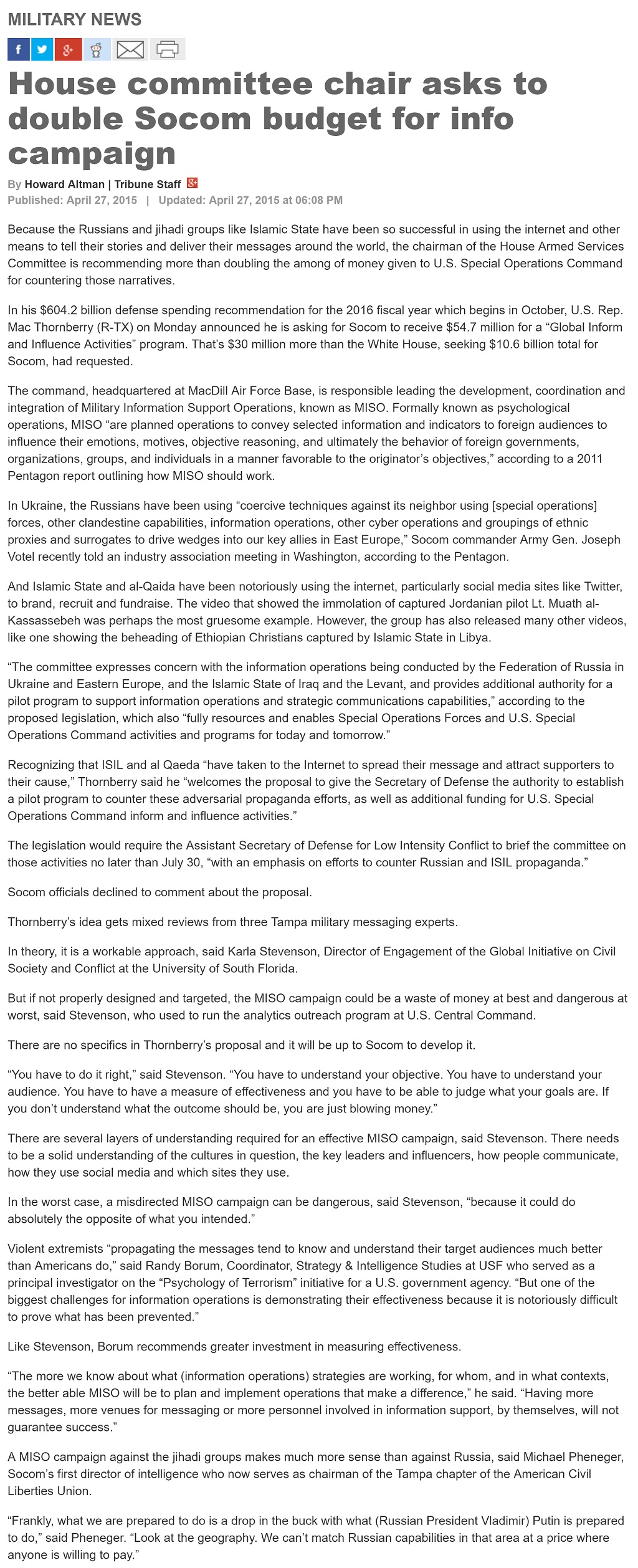
Because the Russians and jihadi groups like Islamic State have been so successful in using the internet and other means to tell their stories and deliver their messages around the world, the chairman of the House Armed Services Committee is recommending more than doubling the among of money given to U.S. Special Operations Command for countering those narratives.
In his $604.2 billion defense spending recommendation for the 2016 fiscal year which begins in October, U.S. Rep. Mac Thornberry (R-TX) on Monday announced he is asking for Socom to receive $54.7 million for a “Global Inform and Influence Activities” program. That’s $30 million more than the White House, seeking $10.6 billion total for Socom, had requested.
The command, headquartered at MacDill Air Force Base, is responsible leading the development, coordination and integration of Military Information Support Operations, known as MISO. Formally known as psychological operations, MISO “are planned operations to convey selected information and indicators to foreign audiences to influence their emotions, motives, objective reasoning, and ultimately the behavior of foreign governments, organizations, groups, and individuals in a manner favorable to the originator’s objectives,” according to a 2011 Pentagon report outlining how MISO should work.
In Ukraine, the Russians have been using “coercive techniques against its neighbor using [special operations] forces, other clandestine capabilities, information operations, other cyber operations and groupings of ethnic proxies and surrogates to drive wedges into our key allies in East Europe,” Socom commander Army Gen. Joseph Votel recently told an industry association meeting in Washington, according to the Pentagon.
And Islamic State and al-Qaida have been notoriously using the internet, particularly social media sites like Twitter, to brand, recruit and fundraise. The video that showed the immolation of captured Jordanian pilot Lt. Muath al-Kassassebeh was perhaps the most gruesome example. However, the group has also released many other videos, like one showing the beheading of Ethiopian Christians captured by Islamic State in Libya.
“The committee expresses concern with the information operations being conducted by the Federation of Russia in Ukraine and Eastern Europe, and the Islamic State of Iraq and the Levant, and provides additional authority for a pilot program to support information operations and strategic communications capabilities,” according to the proposed legislation, which also “fully resources and enables Special Operations Forces and U.S. Special Operations Command activities and programs for today and tomorrow.”
Recognizing that ISIL and al Qaeda “have taken to the Internet to spread their message and attract supporters to their cause,” Thornberry said he “welcomes the proposal to give the Secretary of Defense the authority to establish a pilot program to counter these adversarial propaganda efforts, as well as additional funding for U.S. Special Operations Command inform and influence activities.”
The legislation would require the Assistant Secretary of Defense for Low Intensity Conflict to brief the committee on those activities no later than July 30, “with an emphasis on efforts to counter Russian and ISIL propaganda.”
Socom officials declined to comment about the proposal.
Thornberry’s idea gets mixed reviews from three Tampa military messaging experts.
In theory, it is a workable approach, said Karla Stevenson, Director of Engagement of the Global Initiative on Civil Society and Conflict at the University of South Florida.
But if not properly designed and targeted, the MISO campaign could be a waste of money at best and dangerous at worst, said Stevenson, who used to run the analytics outreach program at U.S. Central Command.
There are no specifics in Thornberry’s proposal and it will be up to Socom to develop it.
“You have to do it right,” said Stevenson. “You have to understand your objective. You have to understand your audience. You have to have a measure of effectiveness and you have to be able to judge what your goals are. If you don’t understand what the outcome should be, you are just blowing money.”
There are several layers of understanding required for an effective MISO campaign, said Stevenson. There needs to be a solid understanding of the cultures in question, the key leaders and influencers, how people communicate, how they use social media and which sites they use.
In the worst case, a misdirected MISO campaign can be dangerous, said Stevenson, “because it could do absolutely the opposite of what you intended.”
Violent extremists “propagating the messages tend to know and understand their target audiences much better than Americans do,” said Randy Borum, Coordinator, Strategy & Intelligence Studies at USF who served as a principal investigator on the “Psychology of Terrorism” initiative for a U.S. government agency. “But one of the biggest challenges for information operations is demonstrating their effectiveness because it is notoriously difficult to prove what has been prevented.”
Like Stevenson, Borum recommends greater investment in measuring effectiveness.
“The more we know about what (information operations) strategies are working, for whom, and in what contexts, the better able MISO will be to plan and implement operations that make a difference,” he said. “Having more messages, more venues for messaging or more personnel involved in information support, by themselves, will not guarantee success.”
A MISO campaign against the jihadi groups makes much more sense than against Russia, said Michael Pheneger, Socom’s first director of intelligence who now serves as chairman of the Tampa chapter of the American Civil Liberties Union.
“Frankly, what we are prepared to do is a drop in the buck with what (Russian President Vladimir) Putin is prepared to do,” said Pheneger. “Look at the geography. We can’t match Russian capabilities in that area at a price where anyone is willing to pay.”
